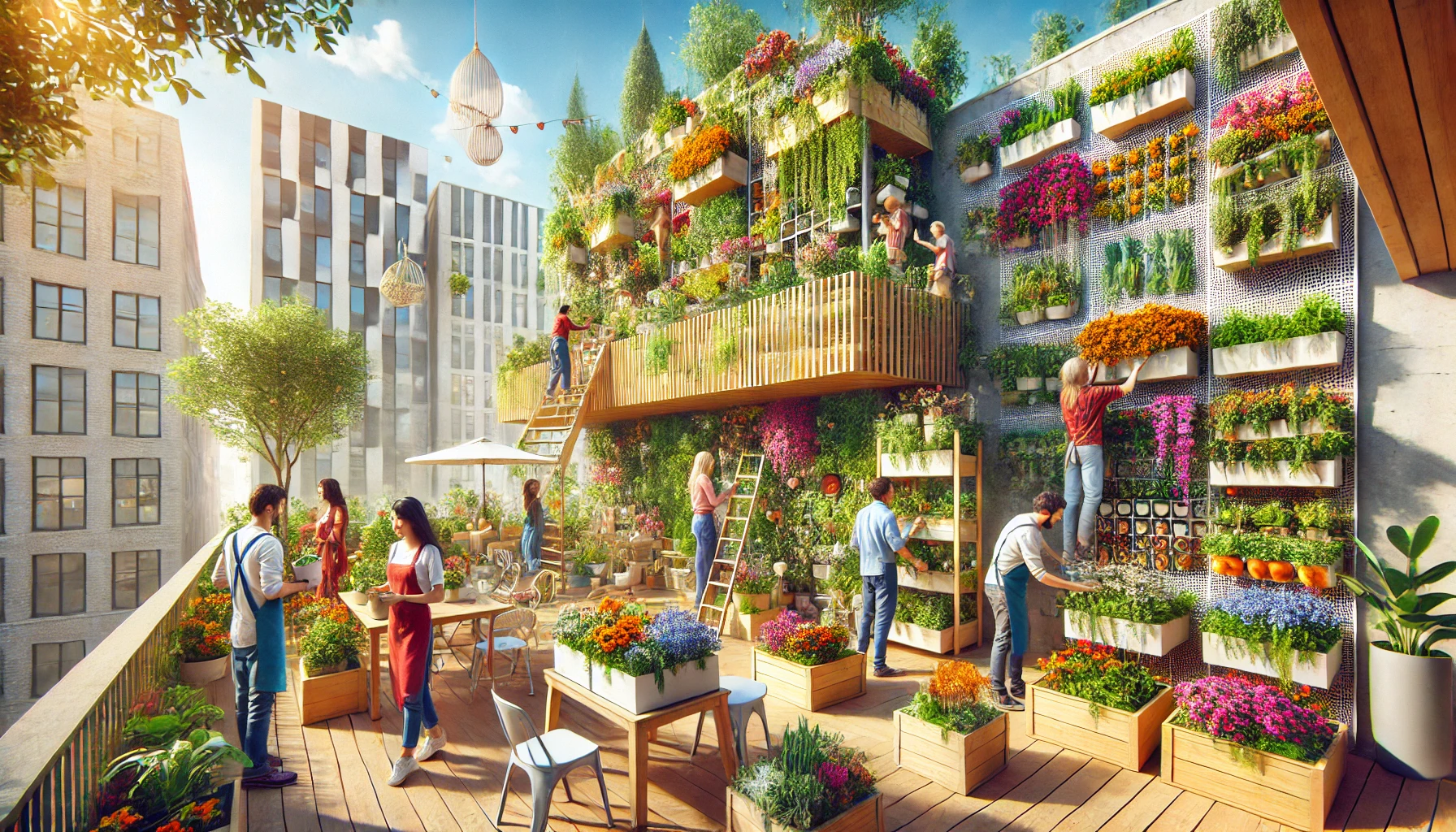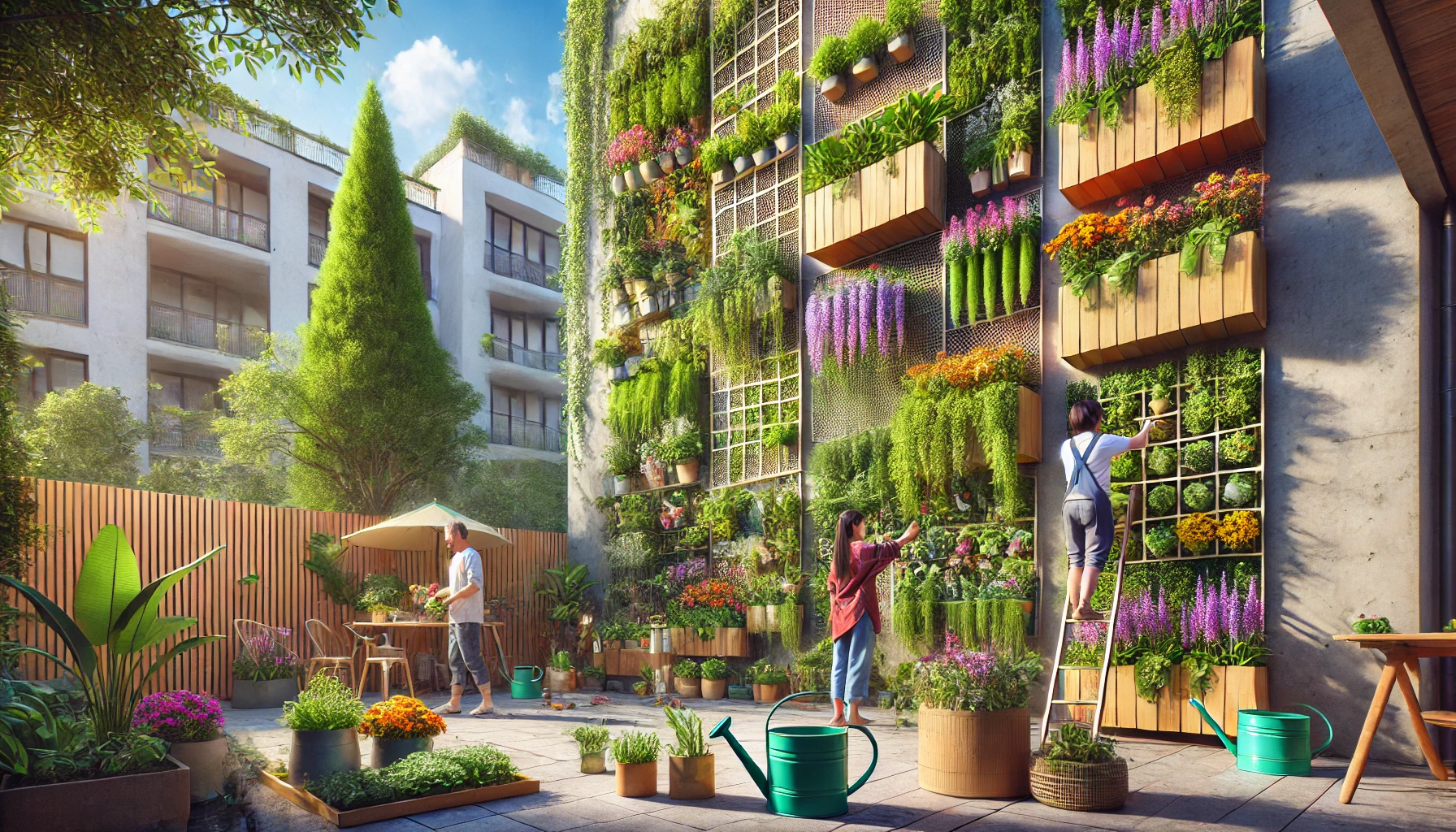In today’s fast-paced world, where urbanization is on the rise and living spaces are shrinking, vertical planting ideas offer a creative solution to maximize limited spaces while bringing a touch of nature to our homes and communities.
This innovative approach to gardening not only optimizes space but also enhances aesthetics and improves air quality, making it an ideal choice for urban dwellers and gardening enthusiasts alike.
Vertical gardening has come a long way from its humble beginnings. Historically, hanging gardens and trellises were among the earliest examples of vertical planting.
Over time, as cities grew and outdoor spaces became more constrained, the concept of vertical gardening evolved into a practical and artistic method of cultivating plants, transforming walls and balconies into lush, green sanctuaries.
The Growing Popularity of Vertical Gardening
One of the reasons vertical gardening has gained immense popularity is its ability to adapt to various environments. Whether you live in a small apartment or own a spacious home, vertical gardening offers a solution for incorporating greenery into your space.
Additionally, the rise of eco-consciousness has further propelled the trend, as people seek ways to live more sustainably and reduce their carbon footprint.
Moreover, the aesthetic appeal of vertical gardens is undeniable. They can transform dull walls into vibrant canvases, create natural privacy screens, and even act as sound barriers in noisy urban areas.
As more people recognize the benefits of vertical gardening, it continues to grow as a hobby, a design trend, and a sustainable practice.
What is Vertical Gardening?
Vertical gardening is a method of growing plants upwards using structures such as walls, trellises, and frames rather than spreading them out horizontally on the ground. This approach maximizes space, making it especially popular in urban environments where outdoor areas are often limited.
Popular Styles and Applications
Vertical gardening is versatile, with applications ranging from small-scale home setups to large commercial installations. Some popular styles include:
- Living Walls: These are fully covered vertical surfaces adorned with greenery, often used as decorative features in homes, offices, or public spaces.
- Trellises and Climbing Frames: Ideal for supporting climbing plants like ivy, beans, and roses.
- Pocket Planters: Fabric or plastic pockets mounted on walls, perfect for herbs and small ornamental plants.
- Vertical Hydroponics Systems: Innovative setups where plants grow in nutrient-rich water instead of soil, saving space and water.
Emerging Trends and Innovations
Recent advancements in vertical gardening have introduced smart gardening technologies, such as automated irrigation systems and app-controlled light setups.
Innovations like biodegradable wall planters and modular systems are also gaining traction, making vertical gardening more accessible and eco-friendly.
Beyond the Home: Commercial Applications
Vertical gardening isn’t limited to homes and apartments. It’s increasingly being used in commercial spaces such as hotels, restaurants, and office buildings.
For instance, many restaurants now grow their own herbs and vegetables on-site using vertical gardens, ensuring freshness and reducing supply chain costs.
Similarly, corporate offices are adopting green walls to improve employee well-being and productivity by creating a more natural and inviting work environment.
Choosing the Right Plants for Your Vertical Garden
Selecting the right plants is crucial to the success of a vertical garden. The choice of plants depends on several factors, including light availability, climate, and whether the garden is indoors or outdoors.
Factors Influencing Plant Selection
- Light Requirements: Assess the amount of natural or artificial light the garden will receive. Some plants thrive in full sunlight, while others prefer shade.
- Climate Conditions: Consider the temperature and humidity of your area. Hardy plants are better for outdoor setups, whereas tropical plants may need controlled environments.
- Space Constraints: Opt for compact or climbing plants that adapt well to vertical growth.
- Maintenance Levels: Determine how much time and effort you can dedicate to maintenance. Beginners may prefer low-maintenance plants like succulents or ferns, while experienced gardeners can experiment with more demanding species.
Top Recommended Plants
For beginners:
- Herbs: Basil, mint, parsley, and thyme.
- Succulents: Aloe vera, jade plant, and echeveria.
- Ornamental Plants: Spider plants, pothos, and ferns.
For experienced gardeners:
- Fruiting Plants: Cherry tomatoes, strawberries, and peppers.
- Climbers: Clematis, morning glory, and bougainvillea.
- Tropical Plants: Orchids, bromeliads, and philodendrons.
Indoor vs. Outdoor Plant Choices
Indoor vertical gardens often rely on plants that thrive in controlled conditions, such as peace lilies and snake plants.
Outdoor vertical gardens, on the other hand, can support a wider variety of plants, including flowering climbers, hardy succulents, and edible plants like lettuce and spinach.
Techniques of Vertical Gardening
Vertical gardening encompasses a variety of techniques, each offering unique benefits and challenges.
Hydroponics and Aeroponics
- Hydroponics: Plants are grown in a water-based, nutrient-rich solution. This soil-free method is efficient and reduces water consumption.
- Aeroponics: Plants are suspended in air, and nutrients are delivered through a fine mist. This method promotes faster growth and uses even less water than hydroponics.
Modular Systems and Pocket Planters
- Modular Systems: Pre-fabricated panels with built-in planters offer easy installation and flexibility. These systems are particularly popular in commercial settings where scalability and uniformity are key.
- Pocket Planters: Affordable and lightweight, these are great for herbs and small flowers but require regular maintenance to prevent waterlogging.
Trellises and Climbing Frames
Perfect for vining plants, trellises and frames provide a sturdy structure for plants to grow upward, creating natural green walls. These methods are especially effective for outdoor spaces like gardens and patios.
Advanced Techniques
- Drip Irrigation Systems: Automating the watering process can save time and ensure plants receive consistent moisture.
- Self-Watering Planters: These innovative systems reduce the need for frequent watering, making vertical gardening more convenient for busy individuals.
- Integrated Lighting: For indoor vertical gardens, LED grow lights can mimic natural sunlight and support plant growth year-round.
Arrangement and Design Ideas for Vertical Gardens
Designing a vertical garden involves more than just planting; it’s about creating a visually appealing and harmonious setup.
Best Practices for Arranging Plants
- Layering: Place larger plants at the bottom and smaller ones at the top for balanced growth.
- Grouping by Care Needs: Arrange plants with similar water and light requirements together.
- Accessibility: Ensure easy access for watering and maintenance.
Crafting an Eye-Catching Design
- Use a mix of colors and textures to create visual interest.
- Incorporate flowering plants to add seasonal vibrancy.
- Experiment with symmetry and asymmetry to match your personal style.
Proportion and Balance
Maintain proportion by choosing planters that match the size of your plants. Balance the design by evenly distributing colors and textures throughout the garden.
How to Maintain and Care for a Vertical Garden
Maintaining a vertical garden requires regular attention to ensure plants remain healthy and vibrant.
Routine Maintenance Tips
- Watering: Use drip irrigation or self-watering systems to maintain consistent moisture levels.
- Fertilizing: Apply liquid or slow-release fertilizers based on plant needs.
- Pruning: Trim overgrown plants to prevent overcrowding and maintain aesthetics.
Pest Control and Plant Health
- Inspect plants regularly for pests and diseases.
- Use natural repellents like neem oil to avoid chemical exposure.
- Rotate plants occasionally to ensure even growth and minimize pest infestations.

Addressing Common Drawbacks of Vertical Gardens
Vertical gardening, while rewarding, comes with its own set of challenges. Here’s how to address them:
Space and Structural Considerations
- Challenge: Limited wall space or structural instability.
- Solution: Use lightweight materials and secure mounting systems to avoid overloading walls.
Cost Concerns
- Challenge: Initial setup costs for systems like hydroponics.
- Solution: Start small with DIY projects and gradually scale up.
Common Misconceptions
- Misconception: Vertical gardens are only for experts.
- Reality: With proper guidance and planning, anyone can create a thriving vertical garden.
Innovative and Inspiring Vertical Garden Projects
Across the globe, vertical gardens have transformed spaces and inspired creativity.
Unique Projects
- Indoor Living Walls: Used in corporate offices to boost employee morale and air quality.
- Urban Farming: Vertical farms in cities produce fresh produce sustainably.
- Educational Spaces: Schools use vertical gardens to teach students about sustainability and gardening.
Future Prospects
Emerging technologies like AI-powered irrigation systems and solar-powered vertical farms promise to make vertical gardening even more efficient and accessible.
Conclusion and Takeaways
Vertical gardening is more than just a space-saving solution; it’s a pathway to sustainable living and creative expression. From selecting the right plants to mastering innovative techniques, vertical gardening offers endless opportunities to bring nature closer to our daily lives.
Whether you’re a beginner exploring a new hobby or an experienced gardener looking to innovate, vertical gardening is a rewarding pursuit. So, why not start today and transform your space into a green oasis that reflects your passion for sustainability and creativity?


Vertical gardening is an amazing idea because it enables you to have a garden even if you have little space. personally, I would like to have a vertical garden outside because I want to plant a variety of plants; however I don’t have a yard so I wait to buy my own home for that. However, I’d probably have one if I have a balcony and plant simple herbs like basil or oregano…
That’s a great idea! Vertical gardening is perfect for small spaces like balconies, and herbs like basil and oregano thrive in them. You don’t have to wait for a yard—you can start small and still enjoy fresh, homegrown plants!